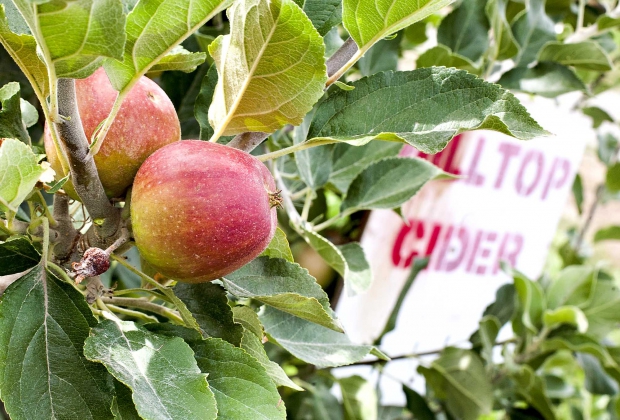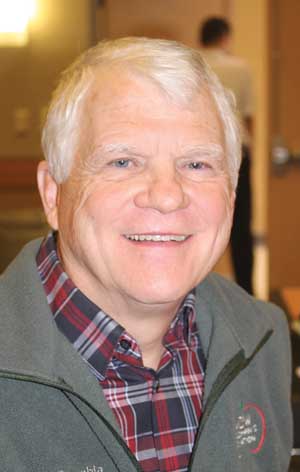
Tieton Cider Works’ “Hilltop Cider” orchard in Yakima, Washington on September 3, 2014.(TJ Mullinax/Good Fruit Grower)
Demand for hard-cider apples is outstripping demand, but anyone thinking of growing them will need some patience before getting started.
Paul Tvergyak, marketing director with Cameron Nursery in Eltopia, Washington, said that while most Washington nurseries have sold cider apples from time to time, none is looking at it as a commercial venture.

Paul Tvergyak
“No one has them in their scion blocks or their inventory,” he told participants at a workshop in Moses Lake in March.
“Availability is an issue—not just for cider apples, but for all apples right now,” he said. “We’ve had a run on rootstocks and on trees this past couple of years, and we’re booked out pretty far into the future.”
Growers wanting cider apples for commercial plantings will probably need to contract with a nursery to grow them, with a minimum order of 1,000 trees, and face at least a two-year wait.
“If you’re thinking of having four to five trees in the backyard to make cider for the family, there are other options,” he said. “Commercial nurseries aren’t going to help you.”
Types of planting material
The standard nursery tree takes two years to grow. A rootstock is planted in the spring and budded with the scion in August. The tree stays in the ground for one more year and is dug in the fall of the second year and stored over the winter, ready for planting the following spring.
Typically, apple trees for commercial plantings cost between $6 and $10 each, depending on the amount of royalties on either the rootstock or the scion variety, though most cider apple varieties would be royalty-free.
An alternative to a full-grown tree is a sleeping eye. This is a rootstock that is planted in the nursery in the spring and budded in August.
At the end of September, the rootstock portion of the top is cut back to the scion bud. The plant is dug in November and put in storage for delivery to the grower the following spring. Because sleeping eyes are dormant, they can be planted out in the orchard early in the year.
Tvergyak said sleeping eyes are cheaper—costing between $1.50 and $2.00 each, or as little as $1.15 for a couple of hundred thousand—and the waiting time is shorter. On the downside, the nursery will guarantee only that the sleeping eyes are true to type, and the grower assumes all the risks of growing them into bearing trees.
“You become the nurseryman, basically, because those are the same products we use to grow two-year-old trees,” Tvergyak warned.
A third option is to plant bench grafts. Nurseries take a rootstock fresh from the layer bed in January or February and graft it with a short stick of wood of the desired variety that has two or three buds. Bench grafts are planted in the orchard in the spring, but not until after the very last frost because they are extremely sensitive to cold. “I’ve seen damage at 37°F,” Tvergyak said.
Nick Ibuki, horticultural research technician with the Summerland Varieties Corporation in British Columbia, Canada, which supplies fruit trees, said there’s a big difference between planting sleeping eyes or bench grafts and buying ready-grown nursery trees. It takes a lot of time and expertise to grow a nursery tree.
“It’s really a full-time job looking after a nursery of any size and if you don’t look after it you can have stunted trees and it will cost you a lot more than the commercial trees,” he warned.
Tvergyak said commercial growers who have used bench grafts and sleeping eyes say the cost of growing that type of planting material works out the same as the cost of nursery trees, when they account for all the labor involved. The difference is that they can develop the trees exactly as they want them and to match their growing system. Also, cash flow is better because of the lower upfront investment.
Tvergyak said his nursery has grown cider apple trees for about three to four customers who ordered around 1,000 trees or more. In every case, the customer provided the scion wood from their own trees. Much of the budwood comes from one-year-old suckers, and Tvergyak encouraged growers to take wood from the ends of the limbs rather than the trunk in order to increase the probability of the new trees being true to type.
Sherrye Wyatt, executive director of the Northwest Cider Association, asked if a group of association members could submit a bulk order for nursery trees. Tvergyak said his nursery handles bulk orders for a group of growers in New York who have 20 to 40 acres of dessert apples that they grow for their roadside stands. The nursery just asks that they get their orders in early and take delivery at one location.
“That way, we can load a semi and keep separate accounts for each grower—our bookkeeper takes care of that—so that’s a really good idea,” he said.
Ibuki said group orders are much easier for nurseries than small orders, which are a challenge all the way through the production process. “If you can get one person to quarterback that and get one drop-off location, it’s easier, and it’s a lot cheaper, too. It brings the price down.”
The seminar, “Hard Cider from Orchard to Shelf,” was presented by the Northwest Agriculture Business Center at Big Bend Community College. •
——
SVC has cider budwood
Summerland Varieties Corporation (SVC) in British Columbia, Canada, can supply cider apple budwood to growers and nurseries, but it only has a small quantity compared to popular dessert varieties, said Nick Ibuki, operations manager.
SVC is a variety rights management company, which manages apples and cherries developed at Agriculture and Agri-Food Canada’s breeding program in Summerland, as well as other varieties. But it also has a 20-acre virus-free budwood orchard with around 500 different varieties.
It serves as a repository of material that is available for growers in North America and includes the following cider varieties.
Sweets (Less than 0.2 percent tannins; less than 0.45 percent malic acid): SVC has Calville Blanc, Golden Russet, the new variety from Japan called Miki Life, and Sweet Coppin. However, Ibuki said B.C. growers tend not to grow sweet cider varieties but use culls of dessert apples instead.
Bittersweets (More than 0.2 percent tannins; less than 0.45 percent malic acid): Dabinett is the primary bittersweet apple used for cider, though SVC also has Michelin, Muscadet de Dieppe, Bulmer’s Norman, Porter’s Perfection, and Yarlington Mill.
Sharps (Less than 0.2 percent tannins; more than 0.45 percent malic acid): Varieties include Bramley’s Seedling, the Burgundy apple from New York, Esopus Spitzenberg (Thomas Jefferson’s favorite apple), and Winesap. However, some growers are using Cripps Pink, Pink Lady, and Granny Smith as their sharp varieties, Ibuki said.
Bittersharp (More than 0.2 percent tannins; more than 0.45 percent malic acid): The most popular variety in this category is Kingston Black, which makes a good single-variety cider.






Leave A Comment